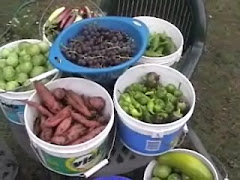
 I picked a grand salad last night, full of hearty greens that become all the more flavorful in the coolness of Autumn. In this years winter gardens we are growing Tuscan, Russian, Blue Curled, and Lacinato Rainbow kale the first being the least hardy of the bunch.
I picked a grand salad last night, full of hearty greens that become all the more flavorful in the coolness of Autumn. In this years winter gardens we are growing Tuscan, Russian, Blue Curled, and Lacinato Rainbow kale the first being the least hardy of the bunch.
 Underneath the row covers one will also find Treviso radicchio, a plant that performs marvelously in the late fall and early spring gardens in part, I believe, because of its long tap roots that help to give it staying power...as long as the voles don't find them.
Underneath the row covers one will also find Treviso radicchio, a plant that performs marvelously in the late fall and early spring gardens in part, I believe, because of its long tap roots that help to give it staying power...as long as the voles don't find them.Parsley, another true "superfood," makes up a fair portion of our winter salads with its extremely nutrient dense foliage.
 Red Veined sorrel may be on of the least flavorful additions to the garden but given its beauty and enduring nature how can we possibly resist growing it? Once established this plant will readily re-seed itself...everywhere.
Red Veined sorrel may be on of the least flavorful additions to the garden but given its beauty and enduring nature how can we possibly resist growing it? Once established this plant will readily re-seed itself...everywhere.We love to grow turnip greens as they seem to thrive and even grow a little in the extreme cold weather, we plant both leaf and root turnip seeds in the fall and are often rewarded with little turnip bulbs in the very early spring.
 Two of this years cold frames have transplanted radicchio and seeded arugula in them, we have quite a bit of luck getting arugula seedlings to overwinter and provide nice greens for late February salads.
Two of this years cold frames have transplanted radicchio and seeded arugula in them, we have quite a bit of luck getting arugula seedlings to overwinter and provide nice greens for late February salads.
 A couple other plants that have recently surprised us with their cold hearty nature are the liquorice flavored chervil and Ruby Streaks mustard. Both are rather feathery and fine without much bulk but do impart a nice combination of flavors.
A couple other plants that have recently surprised us with their cold hearty nature are the liquorice flavored chervil and Ruby Streaks mustard. Both are rather feathery and fine without much bulk but do impart a nice combination of flavors.

Outside of the row covers and cold frames the Bulls Blood beets and leftover Giant Red Celery are still providing us with a nice amount of greens or reds in the case of the beet leaves.


I planted a bed of "experimental winter density lettuces" that I know will not grow too much under these cold conditions but am hoping will put forth enough root to allow them to possibly spring forth when the weather finally warms. I did this because I had a few of these lettuces overwinter under cover of snow last season. If they fail it will be not be a wasted effort as I interspersed the row with time tested bunching onions that I know will manage the cold and provide for us in the spring.

We are also growing Swiss chard, salad burnett, various mints, oregano, and spinach. This post is dedicated to my wife who has been away for the past few days and has been inquiring about our "salad bar."



















 Layer with some carefully sauteed (caramelized) onions and garlic
Layer with some carefully sauteed (caramelized) onions and garlic  Top with a few red or green peppers and more seasoning
Top with a few red or green peppers and more seasoning Bake at 350 for 30 minutes
Bake at 350 for 30 minutes Enjoy dinner as if it were dessert
Enjoy dinner as if it were dessert This most delicious recipe can be found at -
This most delicious recipe can be found at - 






























